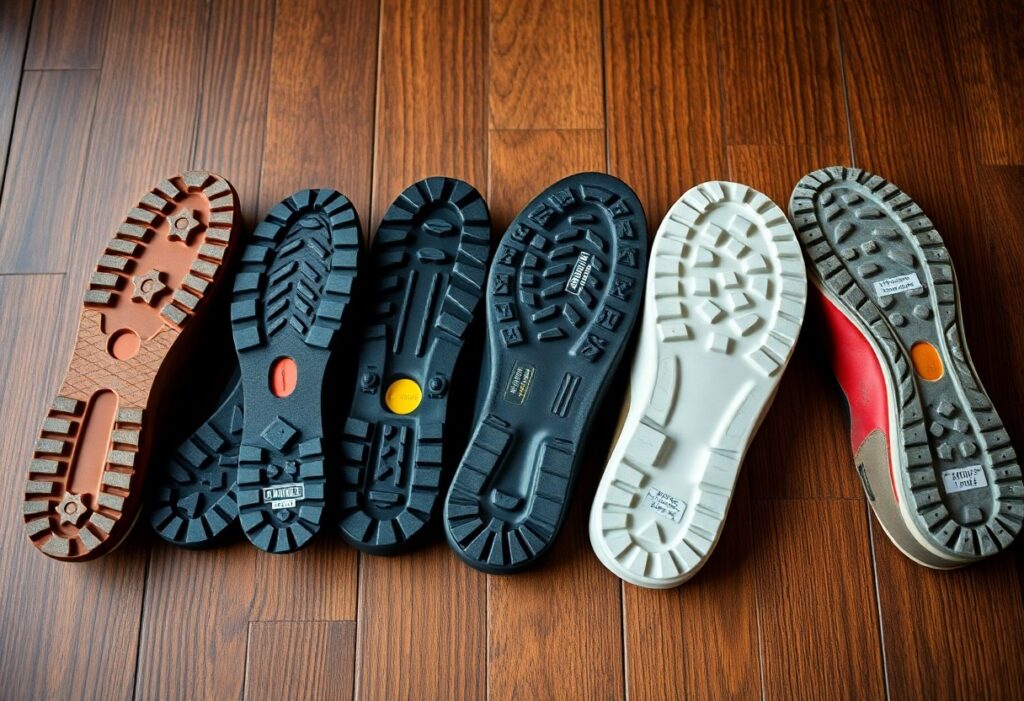
Most people overlook the importance of shoe soles when buying footwear, yet this component directly affects your comfort and safety. Your choice of sole can make the difference between stable footing on wet surfaces or dangerous slips, and between lasting comfort or rapid wear. From traditional leather soles to modern rubber compounds, each type offers specific benefits for different uses. You’ll find various options like single leather, double leather, rubber, and hybrid soles, each designed for specific conditions and wearing purposes. This guide will help you understand the key features of different sole types and select the best option for your specific needs, whether you need shoes for business, casual wear, or outdoor activities.

Leather Soles
Your choice of leather soles can define your footwear’s character and performance. These traditional soles offer superior breathability and natural comfort, molding to your feet over time. While they require more maintenance than synthetic options, leather soles provide excellent ground feel and are ideal for formal occasions.
Single Leather Soles
Soles made from a single layer of leather represent the most classic choice for dress shoes. You’ll find these soles provide excellent flexibility and a refined appearance. They offer better breathability than rubber alternatives but require careful maintenance in wet conditions.
Double Leather Soles
With two layers of leather, these soles give you enhanced durability and better insulation against cold surfaces. You’ll notice they’re slightly stiffer than single soles but provide more protection for your feet.
For instance, your double leather soles will last significantly longer than single soles, making them an excellent choice for daily wear. They’re particularly suitable for heavier builds and outdoor use, though they require a longer break-in period.
HAF (Half and Full) Soles
Single leather in the waist and heel combined with double leather in the forepart gives you the best of both worlds. You’ll get extra durability where needed while maintaining a sleek profile.
Also, your HAF soles provide balanced weight distribution and improved comfort. The design helps protect high-wear areas while keeping the shoe’s elegant appearance intact. However, ensure your cobbler adds proper heel compensation for optimal balance.
Natural and Mixed Soles
Clearly, natural and mixed soles offer you a balanced combination of comfort and durability. These soles blend organic materials like cork, natural rubber, or leather with synthetic compounds to create versatile footwear solutions. Your choice between different natural and mixed soles depends on your specific needs for grip, weight, and weather resistance.
Nitrile Cork Soles
Beside traditional rubber options, nitrile cork soles give you a lightweight alternative that maintains excellent durability. These soles combine cork with nitrile rubber, making them 30% lighter than standard rubber soles. You’ll find them most commonly on American shoes and boots, available in both smooth and treaded patterns.
Crepe Soles
Natural crepe soles, made from pure rubber, provide you with exceptional comfort through their soft, cushioning properties. These soles work best for casual footwear and offer varying levels of grip depending on surface conditions.
Indeed, while crepe soles give you superior comfort for everyday wear, they do have limitations. Their soft nature means they wear down 40% faster than traditional rubber soles, and their grip can be unpredictable on wet surfaces. You’ll need to consider replacing them more frequently, but many users find the comfort worth the trade-off.
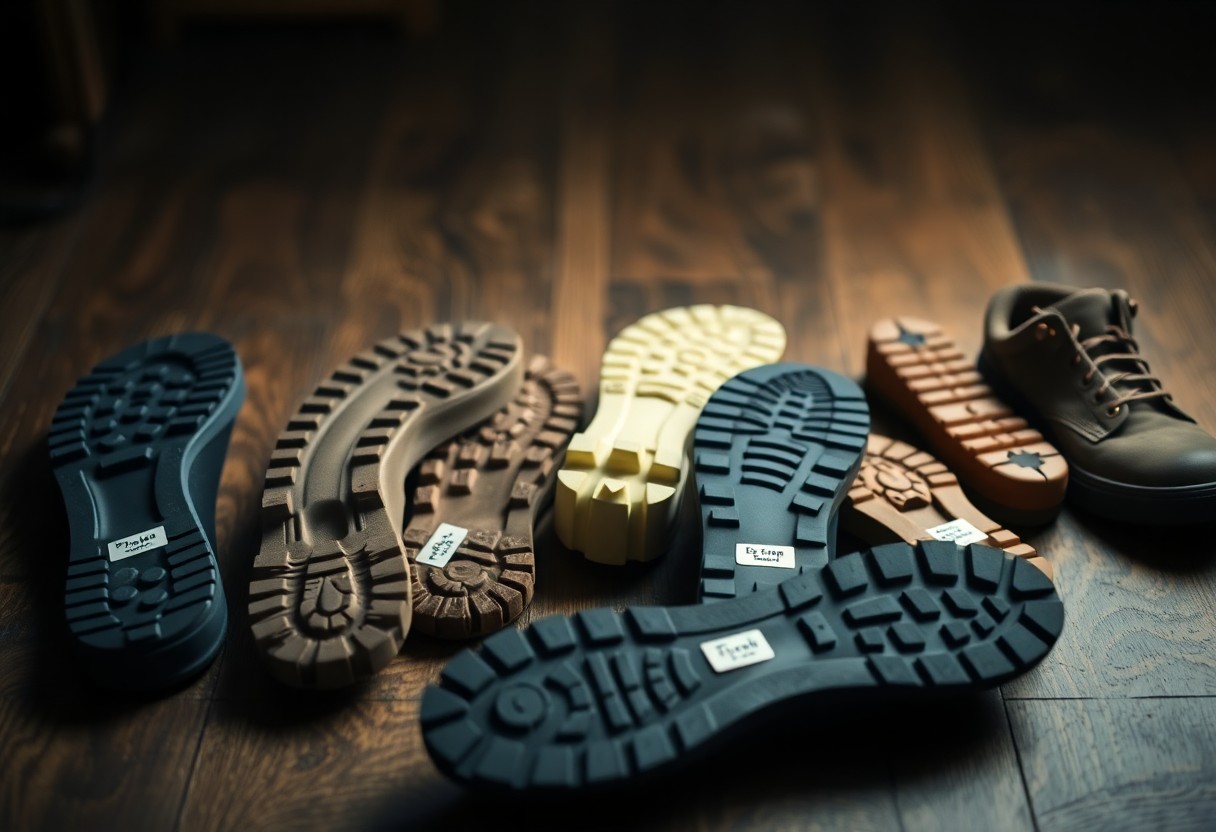
Rubber Soles
For shoes and boots, rubber soles offer superior grip and water resistance compared to leather soles. You’ll find these soles particularly useful in wet conditions, making them your ideal choice for daily wear in varied weather. Rubber soles provide excellent durability and require less maintenance than leather options, though they may feel warmer on your feet during summer months.
Rubber Topy
An excellent compromise between leather and rubber soles, Topy offers you the best of both worlds. You get the traditional appearance of leather soles while gaining improved grip and durability. The thin rubber layer is cemented onto a slightly sanded leather sole, extending your shoe’s lifespan by up to 50%.
City Rubber
By choosing city rubber soles, you get a sleek, dress shoe appearance with enhanced practicality. These thin rubber soles closely resemble leather soles while providing better traction and waterproofing. You’ll find them increasingly popular in modern dress shoes.
In addition to their aesthetic benefits, city rubber soles offer you improved longevity compared to leather soles. Your shoes will require less frequent resoling, making them a cost-effective choice for daily wear. These soles perform exceptionally well in urban environments, handling concrete sidewalks and occasional rain with ease.
Dainite and Studded
Above other rubber options, Dainite and studded soles provide you with maximum durability and grip. The distinctive studded pattern offers reliable traction while maintaining a formal appearance. You’ll find these soles particularly suitable for business casual footwear and dress boots.
Even though Dainite soles are highly resistant to wear, you should note they can become slippery in temperatures below freezing. Your comfort may vary as some users find them firmer than other sole types. For everyday use in moderate conditions, these soles typically last 2-3 times longer than traditional leather soles.

Performance Features
Once again, your shoe sole choice directly impacts your daily comfort and safety. Different sole types offer varying levels of grip, shock absorption, and flexibility. Each feature serves specific purposes, from preventing slips on wet surfaces to reducing foot fatigue during long walks.
Durability Factors
Across different sole materials, wear resistance varies significantly. Rubber compounds typically last 3-4 times longer than leather soles, while nitrile cork offers a middle ground. Material density and tread pattern play key roles in longevity. Knowing these factors helps you make cost-effective choices for your specific needs.
Weather Resistance
Factors like water resistance, temperature tolerance, and traction determine how your soles perform in different conditions. Rubber soles provide superior grip in wet conditions, while leather soles excel in dry weather.
It’s imperative to note that temperature changes affect sole performance significantly. Some rubber compounds become dangerously hard below freezing, while others maintain flexibility. Your local climate should guide your choice – city rubber soles work best in mild wet conditions, while specialized winter soles offer better safety in snow and ice.

Selection Guide
Not all shoe soles are created equal – your choice should match your specific needs. The right sole can make a significant difference in your comfort, safety, and shoe longevity. This guide will help you select the best sole type based on your lifestyle, activities, and environmental conditions.
Usage Considerations
Among the key factors to consider are your daily activities and walking surfaces. For office work, thin leather or city rubber soles work well. For industrial settings, thick rubber or studded soles provide better protection. For outdoor activities, consider grip requirements and durability needs. Knowing your primary use will help narrow down your options.
Climate Factors
Beside weather conditions, temperature variations affect sole performance. Consider these necessary factors:
- Wet conditions – rubber soles offer superior grip
- Cold weather – thicker soles provide better insulation
- Hot climate – breathable leather soles work best
- Variable weather – hybrid soles offer versatility
Knowing your local climate patterns helps select the most suitable sole type.
Consequently, you need to consider how different sole materials perform in various weather conditions:
- Leather soles need special care in wet conditions
- Rubber soles become very hard below 0°C
- Nitrile cork provides good balance in moderate conditions
- City rubber soles offer year-round versatility
Knowing these characteristics ensures your footwear performs well in any season.
Maintenance and Care
Many shoe and boot soles require regular maintenance to ensure their longevity and performance. Your sole’s lifespan depends on proper care, which includes cleaning, drying, and protective treatments. Different sole materials need specific care approaches – leather soles need waterproofing, while rubber soles require debris removal.
Cleaning Methods
Behind every well-maintained sole is a proper cleaning routine. You should:
- Use a soft brush to remove dirt
- Clean with mild soap and water
- Apply specialized cleaners for specific materials
- Dry thoroughly after cleaning
Recognizing the right cleaning method for your sole type will prevent damage and extend wear.
Preservation Tips
Tips for extending your sole’s life include:
- Rotate your footwear daily
- Use shoe trees for storage
- Apply protective sprays as needed
- Check for wear patterns regularly
Recognizing early signs of wear helps prevent permanent damage.
Methods for preserving different sole types vary significantly:
- Leather soles need waterproofing every 3-4 months
- Rubber soles require checking for cracks
- Cork soles need moisture protection
- Crepe soles should avoid extreme heat
Recognizing your sole type’s specific needs ensures optimal maintenance.
Final Words
Considering all points, your choice of shoe sole will greatly affect your comfort and performance. You need to match your sole type with your specific needs – from leather soles for formal occasions to rubber variants for wet conditions. Your lifestyle, walking surface, and weather conditions should guide your selection. A single leather sole offers elegance for dress shoes, while Dainite or city rubber soles give you better grip and durability. By understanding these different sole types and their benefits, you can make better footwear decisions that serve your daily requirements and preferences.
FAQ
What are the main differences between leather and rubber soles?
Leather soles offer better breathability and mold to your feet over time, making them ideal for dress shoes. They work well in dry conditions but need care in wet weather. Rubber soles provide better water resistance and grip, last longer, and work better in various weather conditions. Rubber soles are also generally less expensive and require less maintenance than leather soles.
How do I choose the right sole type for my daily needs?
Consider your main use environment and activities. Pick leather soles for formal office wear and indoor use. Select rubber soles for outdoor walking and wet conditions. Choose studded soles like Dainite for versatile use in different weather conditions. For casual wear, crepe soles offer comfort but wear out faster. Match the sole type to your most frequent activities and weather conditions.
What are the benefits of double soles versus single soles?
Single soles provide better flexibility and a sleeker look, making them suitable for dress shoes. Double soles offer more durability and better insulation against cold and wet conditions. They work well for casual shoes and boots but need longer break-in time. Double soles also add weight to the shoe but provide extra protection for rough terrain.

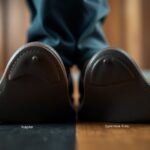

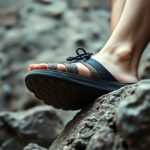

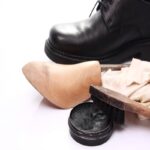


It’s fascinating how often the soles of shoes are neglected in discussions about footwear choice. I’ve always found that the right sole makes a huge difference! For instance, I once opted for a pair of double leather-soled shoes for a job interview, and not only did they offer incredible support, but they also molded beautifully to my feet over time. It’s interesting that while some prefer the classic aesthetic of leather, others might lean towards rubber for traction—especially in wet conditions.
You bring up a great point about the soles of shoes and their significant impact on overall comfort and functionality. When I think about it, the sole can completely change the character of a shoe, providing not just support but also influencing our confidence while we wear them. Your experience with double leather-soled shoes at a job interview really highlights how well-made footwear can offer both comfort and style when it matters most.
You make an interesting observation about the role of shoe soles in both comfort and confidence. I’ve found that the type of sole can really set the tone for not just how a shoe feels but also how we carry ourselves. I had a pair of well-cushioned sneakers that felt like walking on clouds, and wearing them would always boost my mood, especially during long days at work.
You make a really great point about how shoe soles can influence not just comfort but also our overall demeanor. It’s fascinating how something as seemingly simple as footwear can affect our mood and posture throughout the day. I can relate to that feeling you described with your cushioned sneakers. I have a pair of shoes that feel incredibly supportive, and on days when I know I’ll be on my feet a lot, I always reach for them. There’s something reassuring about knowing you have that little extra comfort beneath you.
You’ve nailed it! It’s wild how much our choice in footwear can set the tone for our day. Those supportive shoes aren’t just a luxury; they really boost your confidence and energy. It’s like having a solid foundation. When my sneakers cushion my steps, I feel more ready to take on whatever comes my way.
You’re spot on about that sense of support footwear can give us. It’s interesting how we often overlook the little daily choices, like our shoes, and how they can shift our whole vibe. I totally get the feeling you experienced with your cushioned sneakers. When I slip into my favorite pair, it’s like a small, comforting embrace.
It’s so true how the right shoes can change our mindset, isn’t it? I think the magic lies in that little boost of comfort and confidence. It’s like they create a mini sanctuary for our feet, allowing us to tackle the day more comfortably. It’s amazing to think that something as simple as footwear can influence our mood and even our interactions with others. Have you ever noticed how slipping on your favorite pair can make mundane tasks feel more enjoyable? It’s those small joys that really add up, creating a sense of well-being that can ripple through our day.
I really resonate with what you’re saying about the transformative power of the right shoes. It’s fascinating to consider how something as seemingly simple as footwear can have such a profound impact on our overall mindset and daily experiences. I often find that putting on my favorite sneakers instantly puts me in a better frame of mind, almost as if they carry a bit of that comfort and familiarity with them wherever I go.
It’s really interesting how shoes can have such a psychological impact, isn’t it? Your experience with well-cushioned sneakers definitely resonates. When you’re comfortable, it naturally affects your mood and how you navigate your day. I think it goes deeper than just physical comfort, too—there’s something about the act of wearing shoes that make us feel more grounded or confident.
I completely relate to your thoughts on the importance of soles in footwear choice. It’s intriguing how often they’re overlooked, especially since the right sole can influence not just comfort but also performance. I’ve had my share of struggles with poorly constructed shoes that just didn’t hold up, particularly during long days.
I can relate to the importance of soles; I recently discovered some great options for barefoot sneakers that really prioritize comfort and support while still looking stylish.
‘Sneakers Barefoot: Shop Barefoot Sneakers for Women Now!’
https://myshoesfinder.com/barefoot-shoes-women/sneaker-shoes-for-women/.
It’s great to hear that you can relate to the significance of soles in footwear. It’s easy to overlook how crucial they are until we experience discomfort or fatigue during a long day on our feet. The experience of poorly constructed shoes can truly be frustrating; it often leads to a ripple effect, where the discomfort diminishes our overall performance and enjoyment, whether we’re at work, out for a walk, or hitting the gym.
I can definitely relate to your experience with soles in footwear. It’s remarkable how such a fundamental aspect of shoes can significantly impact our daily lives, especially when we rely on them for comfort and support during long periods. I know what it’s like to be on your feet all day and feel the difference when shoes don’t offer the right support.
I completely resonate with your insights on soles in footwear. It’s fascinating how the right support can make such a noticeable difference in our day-to-day activities. I remember a time when I was working long hours on my feet, and I tried various shoe brands, thinking it was all about style. It took a while to realize that comfort and proper support were priorities I shouldn’t compromise on.
You raise a great point about how often the soles of shoes get overlooked in these discussions. It’s true that the soul of a shoe—the sole—can significantly influence not just comfort but the entire experience of wearing them. You’ve shared a valuable personal touch with your choice of double leather soles for that job interview. The way shoes mold to your feet over time is a testament to the relationship we can build with our footwear. There’s something satisfying about a shoe that adapts to you rather than the other way around.
You really touched on something important there—the way the sole of a shoe can transform the entire wearing experience. I’ve always thought of shoes as more than just a covering for our feet; they’re almost like companions that we rely on through various life experiences.
You’ve highlighted such an interesting aspect of footwear that often gets brushed aside. The experience of finding that perfect shoe—one that becomes a part of you—is really unique. I think it ties into a larger conversation about how we sometimes overlook the importance of comfort in our fast-paced lives, not just in shoes but in many aspects of our daily routines.
You bring up such a crucial point about shoe soles! It’s fascinating how often they’re an afterthought, despite their impact on our daily comfort and safety. Personally, I’ve always leaned towards rubber soles for my outdoor adventures. They really do provide that extra grip on slippery trails.
You make such a great point about the importance of shoe soles. It’s true; they often get overlooked, but they play a significant role in our overall experience, especially when we’re out in nature. I’ve also found that rubber soles are a game-changer, particularly on those unsteady trails where every step counts. It’s interesting how certain materials can drastically alter our interaction with the environment.
You touch on something really important about shoe soles that often goes unnoticed, and I’m glad you brought it up. While many people might focus on the upper part of the shoe—style, fit, materials—the sole is where the real functionality lies. It’s what connects us to the ground, and that connection can make or break our experience.
You’ve raised a compelling point about the often-overlooked importance of shoe soles, which are critical not just for comfort but also for overall safety and well-being. I appreciate how you’ve highlighted the diversity in sole materials and their practical implications, as this is something I believe many consumers tend to underestimate.
You nailed it with your observation about shoe soles. It’s easy to overlook them when we’re caught up in style or brand names. But that diversity in materials can really make a difference, especially if you’re on your feet all day or navigating tricky terrain.
This post really resonates with me, especially considering how often we overlook the soul of our shoes—quite literally! I can relate to the experience of investing in a good pair of shoes and then being disappointed because the soles were not suitable for the intended use. I once bought a lovely pair of leather-soled dress shoes for a wedding, which turned into a slippery nightmare on outdoor surfaces. The right sole can truly make a world of difference, and it’s intriguing how even minor choices in footwear can impact our comfort and safety.
I couldn’t agree more about the importance of shoe soles! It’s fascinating how often we focus on style or brand, overlooking what really supports us day in and out. I’ve found that investing in a good pair of shoes with quality soles can make a world of difference, especially for my daily walks. For instance, I switched to shoes with a rubber sole for rainy days and the grip is incredible—way less slipping around!
You’ve touched on a crucial aspect of footwear that often gets overshadowed by the latest style trends or brand names—shoe soles. It’s interesting how the sole can make such a significant impact on our overall experience with a pair of shoes. Personally, I’ve noticed that when I invest time in understanding the sole material and design, it pays off in comfort, performance, and even my health.
Ah, the humble shoe sole—a topic that many might sweep under the rug (or should I say, under the sole?) but one that quite literally supports our lives. It’s incredible how much thought goes into something we often take for granted! If shoe soles had a voting booth, I suspect they’d be running for the ‘Most Overlooked Hero’ award, right alongside the unsung cardboard box and that friend who always reminds us about the importance of hydration.